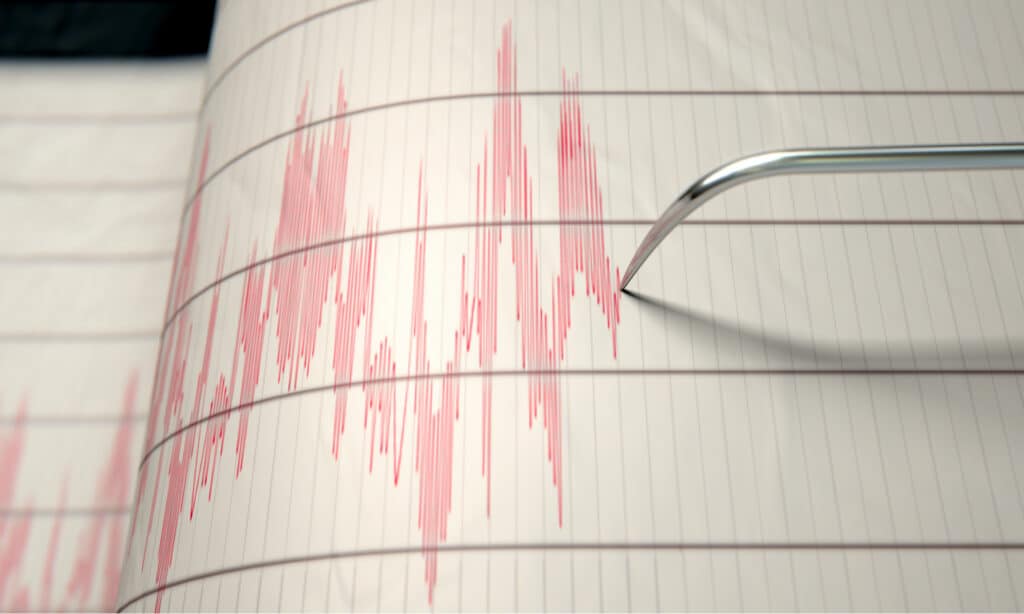The earthquake index is a measurement used to determine the likelihood of an area experiencing earthquakes. It takes into account various factors such as geological characteristics, fault lines, and past seismic activity in the region. This index helps seismologists and geologists predict where earthquakes are most likely to occur and how severe they may be. In Texas, there is one town that has been identified as having the highest earthquake index. This means that residents in this area should take precautions to prepare for potential seismic events. In addition, residents should be aware of emergency protocols in case of an earthquake occurring.
Texas Town Most Likely to Experience an Earthquake

Kermit, Texas is the town most likely to experience an earthquake.
©iStock.com/leekris
According to the latest earthquake data, Kermit, Texas, has been identified as the city with the highest earthquake rating in the state of Texas. The town has scored a 4.14 on the earthquake index. This score indicates that it is more likely than any other location in Texas to experience seismic activity. This finding may come as a surprise to some residents of Kermit and neighboring towns who might not have previously considered their area at risk for earthquakes. However, experts warn that even small tremors can cause damage to buildings and infrastructure over time. As such, it is important for local officials and citizens alike to take precautions against potential earthquakes. This includes preparing emergency plans and ensuring that buildings are constructed or retrofitted according to proper safety standards. While no one can predict when an earthquake will strike, being aware of high-risk areas like Kermit can help communities better prepare for natural disasters. In addition, it will minimize their impact on human lives and property.
A Comparison of Earthquake Risk
According to the earthquake index, Kermit, Texas, has a relatively high risk of experiencing an earthquake, with a rating of 4.14. This is significantly higher than the average for the entire state of Texas. The state of Texas rates at only 0.04 on the same scale. However, compared to other states in the US, Texas has a relatively low risk overall, with a rating of 1.81.
To put these numbers into perspective, McGee Creek, California, ranks at an alarming 167 on the earthquake index. It is one of the highest-risk areas in America for earthquakes. The state of California as a whole also experiences much higher seismic activity than most other parts of America. California ranks at 21.80 on this scale.
These comparisons help us understand just how varied and unpredictable seismic activity can be across different regions within our country and around the world. While some areas may have very low risks for earthquakes, like most parts of Texas, or even lower than that, such as New York City, with its rating being less than 0.58, others face much more frequent threats from potentially devastating natural disasters like those living in Hawaii (rated 13.37).
As we continue to learn more about these patterns and trends over time through ongoing research efforts by experts in seismology and geology alike, we can better prepare ourselves and our communities for any future events that may occur. This can minimize damage caused by them while staying safe during challenging times ahead.
About Kermit Texas

Seismic activity was recorded in Kermit, Texas in 1976 and 1978.
©Inked Pixels/Shutterstock.com
Kermit, Texas, is a small city located in Winkler County with a population of about 5,894 people. Despite its size, Kermit has gained some attention due to its recent increase in seismic activity. The town sits atop the Permian Basin oil field, one of the largest oil reserves in the world. This has led to increased hydraulic fracturing or fracking operations, which have been linked to inducing earthquakes.
According to data collected by the United States Geological Survey (USGS), there were two small earthquakes recorded in Kermit between 1976 and 1978. They were of a 4.1 and 3.5 magnitude. While most of these quakes were not major events on the Richter scale and caused little damage, they have still raised concerns among residents and officials alike.
In addition to its geological activity, Kermit boasts a strong agricultural industry, with cotton being one of its main crops. The town also has several parks and recreational areas for outdoor enthusiasts, including golf courses and fishing lakes.
Despite its recent seismic activity, Kermit remains a tight-knit community that values family-oriented events such as rodeos and county fairs. With easy access to nearby cities like Midland-Odessa and El Paso via Highway 18 or Interstate-20, it offers both peace and tranquility while remaining connected to larger urban centers within driving distance.
Where is Kermit, Texas, Located on a Map?
The city of Kermit, the most likely site of an earthquake in the state of Texas, sits on the corner of the New Mexico border to the west. The cities of Midland and Odessa lie less than an hour from Kermit to the east.
Wildlife Near Kermit
Kermit, Texas, boasts a rich and diverse wildlife population that thrives in its surrounding desert terrain. The town’s unique natural landscape is home to several species of wild animals, including coyotes, bobcats, and roadrunners. Coyotes are known for their adaptability and can be found in many parts of North America. However, the elusive bobcat is indigenous to the region.
In addition to these mammals, people may spot jackrabbits darting around the outlines of the town. These large rabbits have long ears that help them detect predators from afar. They also have powerful hind legs that allow them to escape quickly. However, keep an eye out for another animal – the western diamondback rattlesnake – especially during warmer months when they’re more active.
Despite being poisonous, western diamondback rattlesnakes play an important role in maintaining balance within Kermit’s ecosystem by controlling rodent populations. They are easily identifiable by their distinctive rattle, which warns potential predators against approaching too closely.
For birdwatchers visiting Kermit or residing there permanently, sightings of red-tailed hawks and great horned owls nesting in nearby trees are common occurrences. These majestic birds of prey feed on small rodents like mice or rats. However, they will occasionally hunt larger prey such as snakes or rabbits.
Despite being located in an arid region, Kermit’s animal population thrives due to its proximity to water sources such as ponds and creeks. While some may find these creatures intimidating, they are an important part of what makes Kermit special and offer visitors a chance to experience nature up close.
Wild Animals and Earthquakes
The impact of earthquakes on wildlife is often overlooked and understudied. The sudden shaking and ground ruptures can have significant effects on the habitats and behaviors of various animals. Waterfowl, for instance, may experience changes in their aquatic environments due to the shifting tectonic plates that cause earthquakes. Similarly, deer populations could be disrupted by landslides or other habitat destruction caused by seismic activity.
Burrowing animals like badgers and rabbits are also at risk during an earthquake since tunnels can collapse or shift, changing their access to food sources or leaving them vulnerable to predators. Larger predatory species, such as bobcats and coyotes, may face challenges when prey populations change as a result of habitat disturbances.
Furthermore, smaller creatures like armadillos, skunks, raccoons, snakes, and turtles are also susceptible to the effects of earthquakes. These animals rely heavily on burrows or crevices for protection from harsh weather conditions or predators. However, these underground shelters could become unstable during an earthquake event.
Overall it’s important that we recognize how natural disasters can impact not just human lives but also animal communities. By studying these impacts, we can work towards developing strategies to mitigate risks while preserving local ecosystems for all inhabitants – big or small!
How to Stay Safe in an Earthquake

Planning ahead for a possible earthquake can save lives.
©iStock.com/hapabapa
If you ever find yourself in an area that experiences frequent earthquakes, it is important to know how to stay safe. The first step is to be prepared by having an earthquake kit with essential supplies such as water, non-perishable food, a flashlight, and a first aid kit. It is also crucial to have a plan in place for communication and evacuation.
During an earthquake, the most important thing to do is drop down onto your hands and knees before covering your head and neck with your arms. This position will protect vital organs while allowing you to move quickly if necessary. Stay low until the shaking stops or until you can safely exit the building.
If you are indoors during an earthquake, try not to run outside as there may be falling debris or other hazards that could cause harm. Instead, seek shelter under sturdy furniture like tables or desks until the shaking has ended.
If you are outside during an earthquake, move away from buildings and power lines, as they may collapse during the quake. If possible, find an open space away from trees or streetlights that could fall on top of you.
Overall, staying calm and following these safety guidelines can help reduce injuries and save lives during earthquakes.
The photo featured at the top of this post is © Janece Flippo/Shutterstock.com
Thank you for reading! Have some feedback for us? Contact the AZ Animals editorial team.






